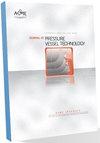Added Mass and Damping of an Hexagonal Rod Vibrating in Highly Confined Viscous Fluids
IF 1.4
4区 工程技术
Q4 ENGINEERING, MECHANICAL
Journal of Pressure Vessel Technology-Transactions of the Asme
Pub Date : 2022-09-02
DOI:10.1115/1.4055438
引用次数: 0
Abstract
This paper deals with fluid-structure interaction analysis of an hexagonal rod enclosed in a narrow viscous gap. A new analytical solution for a 2D cylindrical case is derived and described. A numerical solution of 2D Navier-Stokes equations coupled with an harmonic structure model is applied to both cylindrical and prism geometries. The comparison between the numerical tool and the analytical solution is discussed and a method to apply the analytical solution to the hexagonal case is proposed. An original definition of the added mass and damping based on an energetic approach is provided avoiding the dependence from the geometry and the type of forcing (free or forced vibration). An experimental facility is provided accounting for an hexagonal prism vibrating within a 7 mm enclosure. Free vibration experiments in water allow assessing the added mass and added damping effect on the modal parameters. The fluid flow is affected by a 3D effect - named downstrokes flow - at the top and the base of the assembly because of free surface and stoky geometry. This produces a higher frequency than the 2D theoretical value given both by the analytical solution and the numerical simulation. A geometrybased correction factor is suggested to taken into account in the 2D numerical simulation the 3D effect. Velocity measured within the gap provides further insight on this phenomenon and agrees well with the prediction of the transposed cylindrical analytical model.六方杆在高受限粘性流体中振动的附加质量和阻尼
本文研究了封闭在窄粘性间隙中的六角杆的流体-结构相互作用分析。导出并描述了一个新的二维圆柱壳的解析解。将二维Navier-Stokes方程的数值解与谐波结构模型耦合应用于圆柱和棱镜几何。讨论了数值工具与解析解的比较,并提出了将解析解应用于六边形情况的方法。提供了基于能量方法的附加质量和阻尼的原始定义,避免了几何结构和强迫类型(自由振动或强迫振动)的依赖性。提供了一种实验设备,用于说明在7mm外壳内振动的六角棱镜。水中的自由振动实验允许评估附加质量和附加阻尼对模态参数的影响。由于自由曲面和粗糙的几何体,流体流在部件的顶部和底部受到3D效果(称为下行流)的影响。这产生了比解析解和数值模拟给出的2D理论值更高的频率。提出了一种基于几何的校正因子,以在二维数值模拟中考虑三维效应。在间隙内测量的速度提供了对这一现象的进一步了解,并与转置圆柱分析模型的预测非常一致。
本文章由计算机程序翻译,如有差异,请以英文原文为准。
求助全文
约1分钟内获得全文
求助全文
来源期刊
CiteScore
2.10
自引率
10.00%
发文量
77
审稿时长
4.2 months
期刊介绍:
The Journal of Pressure Vessel Technology is the premier publication for the highest-quality research and interpretive reports on the design, analysis, materials, fabrication, construction, inspection, operation, and failure prevention of pressure vessels, piping, pipelines, power and heating boilers, heat exchangers, reaction vessels, pumps, valves, and other pressure and temperature-bearing components, as well as the nondestructive evaluation of critical components in mechanical engineering applications. Not only does the Journal cover all topics dealing with the design and analysis of pressure vessels, piping, and components, but it also contains discussions of their related codes and standards.
Applicable pressure technology areas of interest include: Dynamic and seismic analysis; Equipment qualification; Fabrication; Welding processes and integrity; Operation of vessels and piping; Fatigue and fracture prediction; Finite and boundary element methods; Fluid-structure interaction; High pressure engineering; Elevated temperature analysis and design; Inelastic analysis; Life extension; Lifeline earthquake engineering; PVP materials and their property databases; NDE; safety and reliability; Verification and qualification of software.

 求助内容:
求助内容: 应助结果提醒方式:
应助结果提醒方式:


